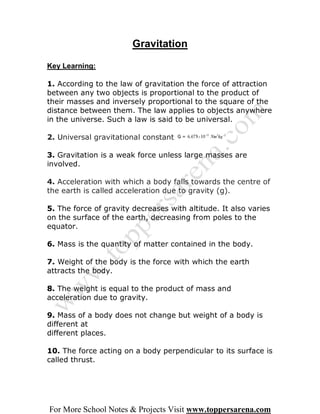
Ix physics full notes chapter 5
- 1. Gravitation Key Learning: 1. According to the law of gravitation the force of attraction between any two objects is proportional to the product of their masses and inversely proportional to the square of the distance between them. The law applies to objects anywhere in the universe. Such a law is said to be universal. 2. Universal gravitational constant 3. Gravitation is a weak force unless large masses are involved. 4. Acceleration with which a body falls towards the centre of the earth is called acceleration due to gravity (g). 5. The force of gravity decreases with altitude. It also varies on the surface of the earth, decreasing from poles to the equator. 6. Mass is the quantity of matter contained in the body. 7. Weight of the body is the force with which the earth attracts the body. 8. The weight is equal to the product of mass and acceleration due to gravity. 9. Mass of a body does not change but weight of a body is different at different places. 10. The force acting on a body perpendicular to its surface is called thrust. For More School Notes & Projects Visit www.toppersarena.com
- 2. 11. The force acting per unit area of the object is known as pressure. 12. The upward force exerted by a liquid when a body is immersed in the liquid is called up thrust or buoyant force. 13. Objects having density less than that of the liquid in which they are immersed, float on the surface of the liquid. If the density of the object is more than the density of the liquid in which it is immersed then it sinks in the liquid. 14. According to Archimedes’ principle, when a body is partially or fully immersed in a fluid, it experiences an up thrust which is equal to the weight of the fluid displaced by the body. Top Formulae: For More School Notes & Projects Visit www.toppersarena.com